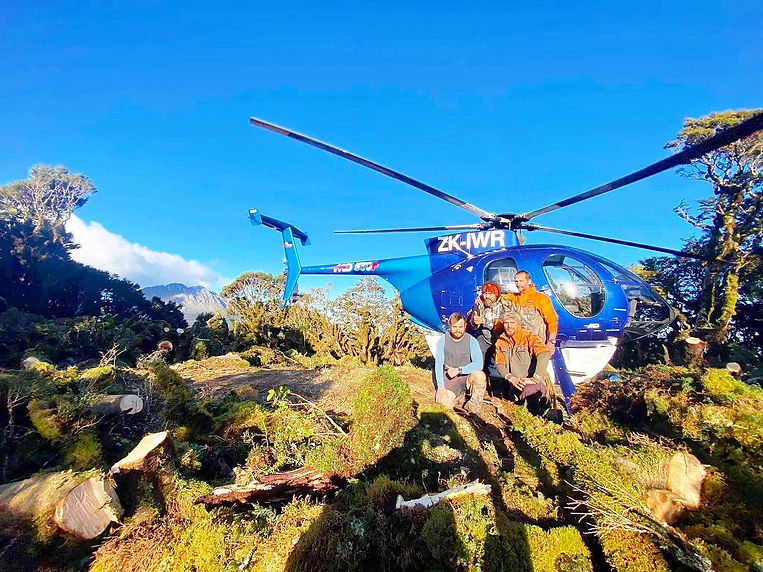
IMS / A 'shop window' into our mahi for te taiao
Many of us are passionate about te Raukūmara, but few really know and understand this ngahere.
Not only is it one of the most isolated and infrequently visited places across te motu, compared to other forests there are few established tracks that go right into the interior, which makes it hard for anyone who does want to explore this beautiful part of the world. While there may not be many formal tracks, there are many ancestral trails, but most of these are no longer common knowledge and are only used infrequently, by the heartiest bush men and women.
Even when you get into this forest, many parts of te Raukūmara are very difficult or impossible to get around. Few of us have been able to see for ourselves and witness the devastating state of te Raukūmara. Only those who travel and/or work there on a regular basis are able to witness the loss and devastation that has occurred over time.
Those who know the interior have no doubt: te Raukūmara is on the brink of ecological collapse.

From the exterior, te Raukūmara looks green, healthy, lush and alive. To those who may have only visited the interior a handful of times, perhaps they don't notice any changes, and don't have memories of anything different. But our experts know...
When our ngahere starts to collapse, it won't be with the sound of a million dead trees hitting the ground all at once.
Ecological collapse is gradual, slow and usually hard to notice, unless you know what you're looking for. The tohu signalling collapse may be small and easy to miss. Little things like just sleeping in one morning, because Papatuanuku's natural alarm clock - the dawn chorus - has finally disappeared. Or noticing that almost every ancient tōtara in an area might be dead or dying, ring-barked by starving deer. Or it could be noticing the signs of a slip, high on the slopes of our maunga where most of us will never see, but that fills our awa with silt and smothers and suffocates our stocks of precious kaimoana.

Our Raukūmara experts spend their days working in these places that are mostly far away, often dangerous and usually hard to access, looking for the signs and doing what they can to return the mana and mauri of our ngahere. They go to these places, and take photos or capture videos, and come back to share with us all what they have seen, heard and learned. What they have experienced drives them in thier passion for this urgent mahi. And they can share their stories with us, but nothing compares to seeing for yourself, or having hands-on experience of a situation.
That's why we have developed local 'Intensively Managed Sites'
'Intensively Managed Sites' (IMS) help people understand the crisis our ngahere faces. Safety, logistics and resources mean we can't take everyone who is interested into the depths of te Raukūmara, so instead, we bring the mahi we are doing deep in the ngahere back into the heart of our community.
We set up IMS in places where whānau can see, watch, learn and be involved in a hands-on, practical way, without having to go too far from home.
IMS are like a 'shop window' - giving everyone the chance to witness the mahi that usually occurs deep in the forest.
Each IMS is an area that is sectioned off and intensive management strategies are applied. Some sites might focus on critical aspects of predator control such as traps, bait, trap shyness, seasonal considerations and long-term sustained suppression strategies; while others might focus on monitoring, or the return of taonga bird and lizard species; or a combination of different aspects of mahi.
The IMS offers different opportunities: from getting face-to-face with some of the introduced predator species that have pushed the ngahere to the brink of extinction, to the development and growth of mātauranga and intergenerational knowledge that will benefit all of us. In this way, each IMS helps whānau learn and understand the state of and our mahi for te taiao, and give them opportunities to train and get qualified for the job opportunities related to this kaupapa.
Four IMS proposed for te Raukūmara
There are four IMS currently proposed for te Raukūmara:
-
Houpoto
-
Anaura
-
Mangaraukokore
-
Whangaparaoa.
Here we will work alongside kura, local marae and anyone else who is passionate about nature-based hands-on learning opportunities specific to their rohe. We'll wānanga to understand the goals and desires of the community and co-develop the IMS plan to reflect whānau aspirations. And where the opportunity presents, we'll work with local industry to produce what we need too - making traps, raising seedlings, helping to train whānau-based experts and more.
IMS are places where we can learn through doing. Where we can share our knowledge, mātauranga and other science to create a depth of understanding and enhanced abilities in our communities. This allows us to communicate to whānau and engage not just with what is happening in the interior of our ngahere but also exactly what is required to halt the collapse and save te taiao.
This approach helps us to safeguard a long term future that sees our upskilled, qualified, experienced and passionate whānau best-placed for employment, management, governance and volunteer opportunities associated with the Raukūmara Pae Maunga kaupapa and beyond. We know that saving te taiao will not be a short term project, but one that is likely to span decades and pass through generations. And while we protect, we connect. We connect and re-connect with ourselves, with each other, with te taiao, around te motu and across te ao.
![Raukūmara_Pae_Maunga_logo__Land_colour[1].png](https://static.wixstatic.com/media/9e159d_5c1694baed5c442a86557b388c0253b4~mv2.png/v1/crop/x_67,y_108,w_1520,h_686/fill/w_129,h_59,al_c,q_85,usm_0.66_1.00_0.01,enc_avif,quality_auto/Rauk%C5%ABmara_Pae_Maunga_logo__Land_colour%5B1%5D.png)


